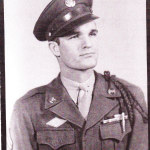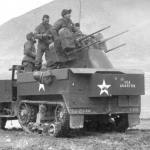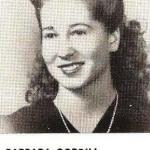 From a hand-me-down 1927 Falcon roadster to an unique Army M-15 Half-Track, Robert D. Fischle’s journey from an Anaheim High graduate to World War II hero involved an amazing collection of unique cars, trucks and other vehicles that not only took him along the roads of life, but defined the path his life would take. Still living in Anaheim near his alma mater, Robert “Fish” Fischle shared his story of serving in WWII in his autobiography, “Small Town Kid to Big Time War.”
From a hand-me-down 1927 Falcon roadster to an unique Army M-15 Half-Track, Robert D. Fischle’s journey from an Anaheim High graduate to World War II hero involved an amazing collection of unique cars, trucks and other vehicles that not only took him along the roads of life, but defined the path his life would take. Still living in Anaheim near his alma mater, Robert “Fish” Fischle shared his story of serving in WWII in his autobiography, “Small Town Kid to Big Time War.”
Before “Fish” writes about his experience as a soldier in WWII, including being a part of the Battle of the Bulge, one of the war’s most famous battles, he fondly recalls his years at Anaheim High. He entered Anaheim High after it was rebuilt due to damage from the 1933 Long Beach earthquake. “I was entering a new school that was almost complete except for the swimming pool and gym,” he writes.
These were innocent times when Bob enjoyed playing football, basketball and running track throughout his four years at AUHS. Like most boys, he was fascinated with cars. His first car during his years at Anaheim Union High School was a Willy’s roadster. When Bob “Fish” Fischle and his best buddy Bob Spielman came up with a quarter, they headed for to the nearest station to fill up on 10.9-cents- a-gallon-gas then headed the roadster to Huntington Beach. He traded in the hand-me-down in his senior year for a 1934 Ford V-8 convertible with roll-up windows and a rumble seat, purchased for $175 from the older brother of his best friend Bob Spielman.
Little did Fischle know during this time of as an Anaheim teenager that life would change dramatically when the Japanese army attacked the Hawaiian Islands on Dec. 7, 1941. He would soon be serving as a gunner of one of the U.S. Army’s most unique vehicles – a M-15 armored anti-aircraft half-track unit with two 50-caliber machine guns that fired 500 rounds per minute and a 37-millimeter canon that fired 120 rounds per minute. The large truck-type vehicle was equipped with front wheels and rear tracks; thus the name half-track.
Robert received his draft notice Jan. 23, 1943, on his 19th birthday, as a student at Fullerton Junior College. Robert reported to Fort MacArthur in San Pedro. His training started at Camp Haan near March Air Force Base, then on to the Mohave Desert to Camp Irwin. He was assigned to the Elite 390th Special Battalion Unit of 675 soldiers. This special battalion was called the “AAA-AW-BN,” which stood for Anti-Aircraft Artillery-Automatic Weapons Battalion.
After a little more than one year of training, Robert’s battalion was shipping out on April 6, 1944 from Camp Shanks, New York, to Glasgow Harbor, Gureck, Scotland, assigned to fight in the Third Army commanded by General George Patton. From June 29, 1944, to his date of discharge four years later, Robert traveled with his Battalion from Scotland, through England, France, Luxembourg, Germany, Czechoslovakia and Austria.
On July 7, 1944, the 390th Battalion landed on Utah Beach with the mission to protect the Third Army’s supply dumps. As they began their advance across Europe, the main objective was to shut down enemy aircraft to prevent destruction of bridges. Keeping these structures intact was of vital importance to the success of U.S. Army operations. “We advanced day and night, over mountains, through dense forests, across broad rivers, pressing ever onward in pursuit of victory,” Robert recalls in his memoirs.
Their 281-day campaign culminated with an important appearance in the Battle of the Bulge, the last major engagement of the United States in the European theater. This 40-day battle, fought in Belgium from Dec. 16, 1944 through Jan. 25, 1945 in the freezing cold, was the largest and bloodiest battle Americans fought in World War II, extending across 90 miles of front, leaving 90,000 Americans wounded and 19,000 dead.
The 390th made history during the Battle of the Bulge, shooting down 13 German planes in 17 minutes. The Germans were in retreat and it was over for the Nazi party and Hitler’s black-coated “SS” troops, also known as the Nazi elite. The 390th Battalion received commendations from U.S. Army General George Patton, General Dwight D. Eisenhower, General Marshall, General Bradley and many more.
The end of March 1945 was the beginning of what has been called the “Rat Race” to Germany. On April 30, 1945, Hitler committed suicide along with his wife of one day, Eva Braun, his mistress of many years; thus, ending the Third Reich and which surrender unconditionally on May 8, 1945.
 After the war ended, Robert returned to Anaheim and married Barbara Cordill, Class of 1944. Barbara passed away Nov. 4, 2014, at age 87.
After the war ended, Robert returned to Anaheim and married Barbara Cordill, Class of 1944. Barbara passed away Nov. 4, 2014, at age 87.
We of the Anaheim High School Alumni Association salute the Anaheim-born Colonist hero.




